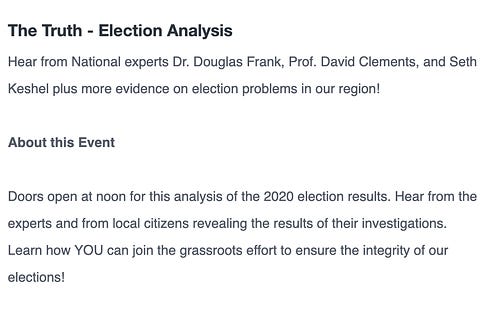Nuts, Bolts, and Advisory Votes
Last week most of the readers of this email (the majority of whom live in eastern Washington State) probably received an 8 1/2 by 11 booklet in the mail entitled “Voters’ Pamphlet, Washington State Elections,” and labelled “2021”. Low on the front page there is a note that says, “Official Publication, Washington Secretary of State, Kim Wyman.” If you opened it and were puzzled by a lack of photos of and statements from the candidates, you were not alone. The only issues covered in the pamphlet are three “Advisory Votes”. Each vote allows you to express your opinion on whether your do or do not “favor” a bill that was passed by the Washington State House and Senate and signed into law by the governor during the last year. The pamphlet states, “Advisory votes are non-binding. The results will not change the law.”
Before discussing these irritating and seemingly pointless “Advisory Votes” and how they came to be, take note that this Washington State pamphlet actually contains a lot of information worth reviewing. Right on the front it says, “Ballots mailed out October 15”. That’s this coming Friday. The ballots need to be voted and turned in by the date of the General Election, November 2, just three weeks from now. On page 3 the pamphlet lays out the deadlines for registering online or by mail to vote in this election (October 25) or in person at your county’s elections office (November 2 by 8PM), explains that a “Local Voters’ Pamphlet” should arrive in your mailbox from the county elections office before or at the same time as your ballot, and directs you to VoteWA.gov for more specific information. Pages 4 to 8 and 18 to 23 of the pamphlet offer other voting background information that is worth paying attention.
You might wonder why the Secretary of State spends our state tax money to send out a state “Voters’ Pamphlet” at all when there are no candidates up for election at the state level in this off-off year election. (The election in our state in off-off, i.e. odd numbered years, are all for local offices and [theoretically] non-partisan.) The answer is that, as with every state in the union, such things are spelled out in state law. RCW (Revised Code of Washington) 29A.32.010 specifies, “The secretary of state shall, whenever at least one statewide measure or office is scheduled to appear on the general election ballot, print and distribute a voters’ pamphlet.” That brings us around to “Advisory Votes” again.
According to that state law, if there were no “Advisory Votes” the Secretary of State would not have to spend our tax dollars to send every registered voter in the state a “Voters’ Pamphlet” this year.
“Advisory Votes” trace back to a Republican operative, Tim Eyman, a man recognized by the far right “Conservative Political Action Conference” (CPAC) with the “Ronald Reagan Award” for his persistent efforts to promote anti-tax sentiment in Washington State by leveraging (and many would say perverting) the initiative process. In 2021 he was convicted of multiple violations of campaign finance law and fined 2.6 million dollars, but his pernicious legacy lives on in state laws modified by his efforts.
To be honest, I was probably among those who voted for I-960 in 2007 (which passed with 51% of the vote), deceived by a vague distrust of government supported by endless Republican rhetoric. As you can read at that link, parts of I-960 were later declared unconstitutional, but I-960’s was constructed so that its remnants live on in the State Voters’ Pamphlet you just received. I-960 is enshrined in state law in RCW 29A.72.283, where even the slanted language of the Advisory Votes is specified:
The description must be formulated and displayed on the ballot substantially as follows:
“The legislature imposed, without a vote of the people, (identification of tax and description of increase), costing (most up-to-date ten-year cost projection, expressed in dollars and rounded to the nearest million) in its first ten years, for government spending. This tax increase should be:
Repealed . . . .
[ ]
Maintained . . . .
[ ]”
“Without a vote of the people”? That is pure Republican anti-tax propaganda paid for with our tax dollars. Of course, “the people” didn’t vote on these bills. We vote for officials to represent us in state government, people we expect to study and vote on both sides of the budget equation, people we can vote out of office if we get disgusted with them. “Should be—Repealed, Maintained” rather than “in favor of or against” plays to idea that the legislature might have done something reprehensible by voting for a tax and to the illusion that the Advisory Vote is binding.
Here we are fourteen years later still living with Eyman’s CPAC endorsed Republican propaganda enshrined in our election system. No legislature is likely to attempt changing the law that requires this nonsense for simple reason that it would surely ignite another round of bluster and anti-government rhetoric. The legislature has more important issues to which to attend.
As you page through the ten pages of “Advisory Votes” in this year’s state-law-mandated Voters’ Pamphlet and review the clutter of useless Advisory Votes on your ballot, review once more the reason for our affliction: this is state-sponsored Republican partisan propaganda brought to you by Tim Eyman and CPAC. Then get past bit of irritation and do your homework: study the candidates, figure out where they are coming from, and vote accordingly.
Keep to the high ground,
Jerry
P.S. Civics can certainly be confusing, but with enough time and diligence the reasons for the way things are can usually be worked out. I’m still puzzling how it came to be that at the state level (at least in Washington State) it is the Secretary of State’s office that oversees elections, but at the county level all the nuts and bolts of elections are administered by the County Auditor’s Office.








